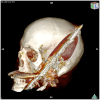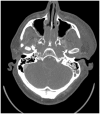Penetrating brain injury after suicide attempt with speargun: case study and review of literature
- PMID: 25071701
- PMCID: PMC4083241
- DOI: 10.3389/fneur.2014.00113
Penetrating brain injury after suicide attempt with speargun: case study and review of literature
Abstract
Penetrating cranial injury by mechanisms other than gunshots are exceedingly rare, and so strategies and guidelines for the management of PBI are largely informed by data from higher-velocity penetrating injuries. Here, we present a case of penetrating brain injury by the low-velocity mechanism of a harpoon from an underwater fishing speargun in an attempted suicide by a 56-year-old Caucasian male. The case raised a number of interesting points in management of low-velocity penetrating brain injury (LVPBI), including benefit in delaying foreign body removal to allow for tamponade; the importance of history-taking in establishing the social/legal significance of the events surrounding the injury; the use of cerebral angiogram in all cases of PBI; advantages of using dual-energy CT to reduce artifact when available; and antibiotic prophylaxis in the context of idiosyncratic histories of usage of penetrating objects before coming in contact with the intracranial environment. We present here the management of the case in full along with an extended discussion and review of existing literature regarding key points in management of LVPBI vs. higher-velocity forms of intracranial injury.
Keywords: ballistic injury; foreign body removal; intracranial antibiotic prophylaxis; neurovascular injury; operative timing; penetrating brain injury; seizure prophylaxis; traumatic brain injury.
Figures








References
-
- fbi.gov. Federal Bureau of Investigation Violent Crime Statistics Report for 2011. Washington, DC: (2013). Available from: http://www.fbi.gov/about-us/cjis/ucr/crime-in-the-u.s/2011/crime-in-the-...
-
- nimh.nih.gov. Suicide Prevention/Information. Washington, DC: National Institute of Mental Health; (2010).
-
- World Health Organization. Suicide Prevention. Geneva: WHO; (2013).
-
- S Kravchenko. Testing of Speargun Performance Using Different Mass, Diameter Spear Shafts and Shooting Line Drag. International Freediving and Spearfishing News (2012).
LinkOut - more resources
Full Text Sources
Other Literature Sources

